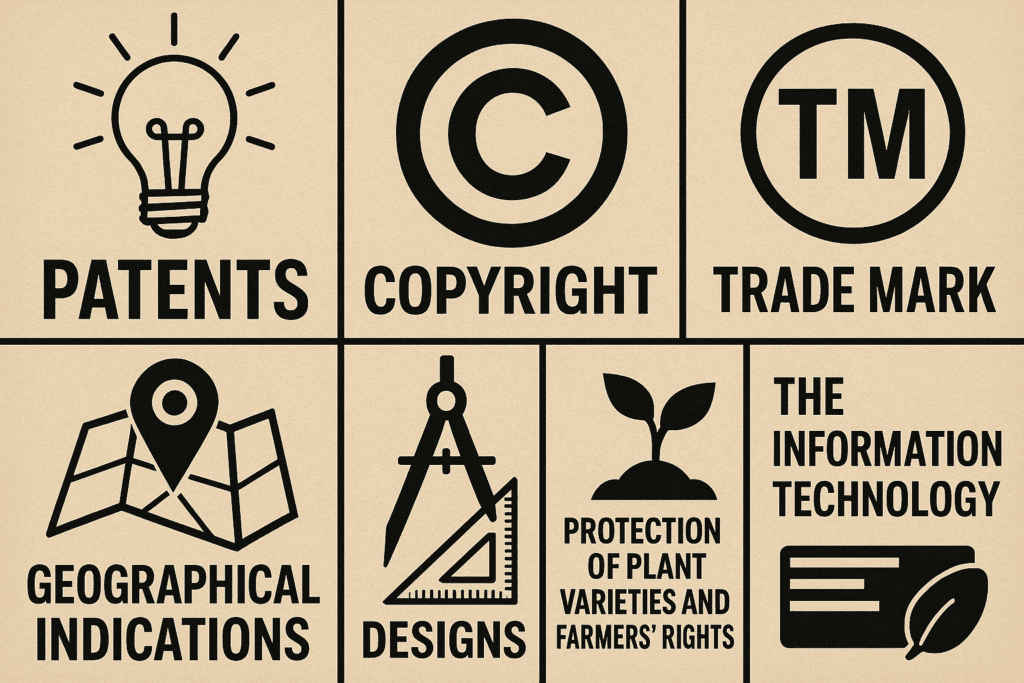Intellectual Property (IP) law in India has undergone a remarkable transformation since the nation became a signatory to the TRIPS Agreement in 1995. TRIPS, or Trade-Related Aspects of Intellectual Property Rights, is a key component of the World Trade Organization (WTO) framework. It harmonized global IP norms by compelling member nations to bring their domestic laws into compliance with minimum international standards.
For a developing country like India, this posed several legal and economic challenges. Yet, it also opened up avenues for stronger protections, innovation incentives, and integration into the global economy. In this blog by Kanoonpedia, we dive deep into how India’s IPR regime evolved post-TRIPS and what key statutes govern it today.

Table of Contents
What Is the TRIPS Agreement ?
TRIPS Agreement was signed in 1994 and came into effect on January 1, 1995. It is administered by the WTO and lays down:
- Minimum standards for the protection and enforcement of intellectual property rights.
- Effective enforcement measures, dispute resolution mechanisms, and transition periods.
- Provisions across patents, copyright, trademarks, industrial designs, geographical indications, trade secrets, and plant varieties.
TRIPS Agreement Objectives:
- Harmonization of IPR protection across countries.
- Elimination of trade distortions caused by inconsistent IP laws.
- Encouragement of technology transfer and innovation.

Major Laws Governing IP in India Post-TRIPS
After signing TRIPS, India undertook a series of legislative overhauls to bring its laws into conformity. Below is a detailed breakdown:
1. The Patents Act, 1970 (Amended in 1999, 2002, 2005)
TRIPS Agreement Impact:
TRIPS requires patent protection for both products and processes in all fields of technology, including pharmaceuticals and agriculture.
Key Post-TRIPS Changes:
- 1999 Amendment: Introduced the concept of Exclusive Marketing Rights (EMRs).
- 2002 Amendment: Compliance with Article 27 (non-discrimination in the grant of patents), term of patent extended to 20 years.
- 2005 Amendment: Product patents were allowed in pharmaceuticals and agrochemicals (a major shift from earlier process-patent regime).
Important Provision:
Section 3(d) prevents evergreening of patents—an India-specific TRIPS-compliant measure.
📌 Case Example: Novartis v. Union of India (2013) — Supreme Court upheld Section 3(d), denying patent to cancer drug Glivec.
2. The Copyright Act, 1957 (Amended in 1999, 2012)
TRIPS Agreement Impact: TRIPS mandates protection of literary, artistic, musical works, software, and databases.
Key Amendments:
- 1999: Introduced software and digital media into the copyright framework.
- 2012: Addressed issues of royalties for authors, compulsory licensing for disabled persons, and protection of rights in the digital age.
Term of Protection: Life of the author + 60 years.

3. The Trade Marks Act, 1999
TRIPS Agreement Impact: Required comprehensive protection and enforcement mechanisms for trademarks, including service marks.
Key Features:
- Protection extended to service marks and collective marks.
- Trademark registration valid for 10 years and renewable.
- Establishment of the Intellectual Property Appellate Board (IPAB) (abolished in 2021 and functions now lie with High Courts).
4. The Geographical Indications of Goods (Registration and Protection) Act, 1999
TRIPS Agreement Impact: Mandated protection of geographical indications (GI) to prevent misuse and ensure exclusivity.
Key Features:
- Recognizes and protects place-based products such as Darjeeling Tea, Kanjeevaram Silk, Mysore Sandalwood, etc.
- Registration provides exclusive rights and legal protection.
💡 To learn more about the GI registration process in India, read our full blog on: Geographical Indications Registration in India
5. Designs Act, 2000
TRIPS Agreement Impact: Required protection of industrial designs with original, novel features.
Key Features:
- Design protection for 15 years (initial 10 years + 5-year renewal).
- Safeguards the aesthetic elements of a product.
6. Protection of Plant Varieties and Farmers’ Rights (PPVFR) Act, 2001
TRIPS Agreement Impact: Mandates member countries to offer plant variety protection (Article 27.3(b)).
India’s Approach:
India adopted a sui generis system balancing breeders’ rights and farmers’ rights.
Unique Provisions:
- Registration of new plant varieties.
- Recognition of farmers as breeders and conservers.
7. The Information Technology Act, 2000
TRIPS Agreement Relevance: Though not exclusively an IPR law, it strengthens digital copyright, software protection, and cybersecurity—areas increasingly relevant in IP disputes.
Institutional and Enforcement Mechanisms
- Office of the Controller General of Patents, Designs, and Trademarks (CGPDTM): Administers patent, trademark, and design registration.
- National IPR Policy (2016): Comprehensive framework to promote innovation, awareness, and IPR commercialization.
- IP Divisions in High Courts: Post-abolition of IPAB, these courts now adjudicate IP disputes.
International Engagements Beyond TRIPS Agreement
India is also a signatory to:
- Paris Convention (1883) – Industrial property protection
- Berne Convention (1886) – Copyright
- Madrid Protocol (for international trademark registration)
- Budapest Treaty (microorganism deposit)
- WIPO Treaties (administered under UN)

PYQs for UPSC & Judiciary Exams
UPSC Previous Year Questions:
- Q1: What is the TRIPS Agreement? How has it affected India’s patent laws? (GS Mains Paper III, 2016)
- Q2: Discuss the implications of Novartis v. Union of India on the Indian pharmaceutical sector.
Judiciary Exam MCQs:
- Which Act governs the protection of plant varieties in India post-TRIPS?
a) Patent Act
b) GI Act
c) PPVFR Act ✅
d) Trade Marks Act - Section 3(d) of the Patents Act aims to:
a) Protect bio-piracy
b) Prevent evergreening ✅
c) Promote licensing
d) None of the above
Challenges in Post-TRIPS IPR Regime
- Balancing Innovation with Access: E.g., affordable medicine vs. patent rights.
- Counterfeit Goods: Despite laws, fake branded goods are rampant.
- Lack of Awareness: Especially among MSMEs, farmers, and creators.
- Digital Piracy: Enforcing copyright in the digital space remains difficult.
- Jurisdictional Overlaps: Some IP disputes still suffer from legal ambiguity.
The Way Forward
India’s journey post-TRIPS has been both dynamic and cautious. While it has largely complied with international mandates, it has also carved out TRIPS-flexibilities to suit national interest, particularly in healthcare, agriculture, and indigenous knowledge.
Recommendations:
- Strengthen IP awareness campaigns for creators and startups.
- Better IP enforcement, especially in e-commerce and digital content.
- Codify digital copyright laws with AI and blockchain in mind.
- Simplify registration processes and reduce pendency.
- Foster research-industry collaboration for better IP commercialization.
The TRIPS Agreement catalyzed a sweeping overhaul of India’s intellectual property laws. Today, the country balances its international obligations with public interest—a model that is now seen as both pragmatic and progressive. Whether you’re a student, creator, entrepreneur, or policymaker, understanding the post-TRIPS IP framework is crucial for participating in India’s innovation economy.
Stay informed with Kanoonpedia , your trusted legal knowledge platform.
The adoption of the TRIPS Agreement (1995) under the World Trade Organization (WTO) marked a global turning point in the regulation and enforcement of Intellectual Property (IP) rights. India, as a WTO member, was obligated to bring its national IP laws into compliance with TRIPS by the early 2000s. This led to a series of substantial legislative reforms to harmonize domestic IP law with international standards while safeguarding national interests like public health and indigenous knowledge.
Let’s walk through the major laws now governing intellectual property in India in the post-TRIPS Agreement landscape:
1. The Patents Act, 1970 (Amended in 2005)
- Pre-TRIPS Agreement: India did not allow product patents in pharmaceuticals and agrochemicals, only process patents.
- Post-TRIPS Agreement Change: The 2005 amendment introduced product patents in all fields of technology, including food, drugs, and chemicals, complying with Article 27 of TRIPS.
- Safeguard Provisions: Section 3(d) was introduced to prevent ‘evergreening’ of patents and protect generic drug access.
Example: The Novartis v. Union of India case (2013) upheld the public interest provisions of the amended Patents Act.
2. The Trade Marks Act, 1999
- TRIPS Alignment: This Act replaced the Trade and Merchandise Marks Act, 1958.
- Key Additions:
- Protection for service marks
- Provision for collective marks
- Well-known marks recognition
- Ten-year registration period with renewability
The Act brought Indian trademark law fully in line with TRIPS, ensuring brand protection in a globalized economy.
3. The Copyright Act, 1957 (Amended in 2012)
- Amendment Objectives:
- Comply with WIPO Internet Treaties
- Recognize rights in digital media
- Strengthen anti-piracy enforcement
- Creator Protection: Stronger moral rights and fair compensation for authors, musicians, and filmmakers.
This law now ensures India’s compliance with TRIPS provisions on literary and artistic works while protecting artists’ economic rights.
4. The Designs Act, 2000
- Replaced: The earlier Designs Act of 1911
- TRIPS Compliance: Provided better protection for industrial designs and aligned with Article 25 of TRIPS.
- Scope: 10 years of protection (extendable to 15), and a faster registration process.
5. The Geographical Indications of Goods (Registration and Protection) Act, 1999
- Context: TRIPS Article 22–24 mandates GI protection.
- Indian Law: Offers protection for products like Darjeeling Tea, Kanjeevaram Sarees, and Basmati Rice.
- Impact: Helps preserve the cultural and agricultural heritage of India while preventing misuse by foreign entities.
6. The Protection of Plant Varieties and Farmers’ Rights Act, 2001
- TRIPS Flexibility: Instead of joining UPOV (an international treaty), India crafted a sui generis system.
- Significance: Balances breeders’ rights with traditional farmer knowledge—an innovative model globally.
TRIPS Agreement Post Effects
Post-TRIPS, India’s intellectual property regime is a hybrid legal framework—one that respects international standards but integrates national priorities. Whether you’re a legal professional, startup founder, or researcher, understanding this evolution is essential for navigating IP law effectively.
🔎 Want to explore the timeline, detailed Information on Intellectual Property Law Career Opportunities in India for everything you need to know.
[…] The legislation’s emphasis on encouraging learning while protecting creators’ rights established a social contract that remains central to copyright law. As we continue to grapple with new challenges in the digital age, the principles established by The Statute of Anne provide valuable guidance for creating intellectual property systems that serve both creators and society as a whole. read more about TRIPS Agreement 1995 […]
[…] TRIPS Agreement […]
[…] Berne Convention and TRIPS have progressively strengthened exclusive rights while constraining member states’ discretion to […]
[…] conflict with normal exploitation, and doesn’t unreasonably prejudice the right holder. The TRIPS Agreement extended the test to all exclusive rights, but WTO panels have confirmed its contextual […]
[…] foreign works are equally safeguarded. While there is no dedicated international tribunal, the TRIPS Agreement (1994) incorporated Berne standards—excluding moral rights—into WTO obligations, […]
[…] around the compatibility of two U.S. statutory exemptions with international obligations under the TRIPS Agreement and the Berne Convention. Section 110(5) of the U.S. Copyright Act […]
Keep up the good piece of work, I read few content on this site and I think that your web blog is rattling interesting and has got lots of fantastic info .